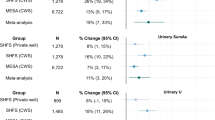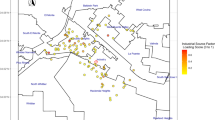Abstract
Arsenic concentration in toenail clippings is used as a biomarker of exposure in epidemiological studies, often under the assumption that a single measurement represents long-term exposure. For this assumption to hold, the measured arsenic concentrations must be stable over time, yet temporal variability has not been adequately assessed. This study aims to evaluate temporal variability in multiple toenail samples collected from a population exposed to drinking water arsenic levels <100 μg/l. Our objectives are to investigate factors responsible for biomarker variability and to assess the suitability of single versus multiple measurements for determining exposure in epidemiological studies. Multiple toenail and drinking water samples were collected from 254 participants enrolled in a case–control study of arsenic exposure and bladder cancer in Michigan, USA; participants also answered questions on water consumption. Toenail samples collected an average of 14 months apart were positively correlated, although a substantial amount of variability was detected (r=0.43, P<0.0001, n=236). Arsenic concentration in drinking water was stable and small changes in drinking water arsenic concentration did not explain variability in toenail arsenic concentration. Change in drinking water consumption, however, was significant in predicting differences in toenail arsenic concentration. Stronger correlations between drinking water arsenic concentration and intake and toenail arsenic concentration were observed when two toenail samples were averaged, suggesting that multiple measurements may more accurately reflect exposure. When exposure was categorized into tertiles and other pre-determined categories, 25–40% of exposures were differentially classified. Only a small percentage (<4%), however, were classified as having low exposure using a single measurement and high exposure when an average of two measurements was used. These results suggest that the use of multiple measurements is unlikely to affect exposure classification of individuals into high- or low-exposure groups; however, collection of multiple samples may be advantageous for more refined exposure classification.
This is a preview of subscription content, access via your institution
Access options
Subscribe to this journal
Receive 6 print issues and online access
$259.00 per year
only $43.17 per issue
Buy this article
- Purchase on Springer Link
- Instant access to full article PDF
Prices may be subject to local taxes which are calculated during checkout

Similar content being viewed by others
References
Ayotte J.D., Baris D., Cantor K.P., Colt J., Robinson G.P., Lubin J.H., Karagas M., Hoover R.N., Fraumeni J.F., and Silverman D.T. Bladder cancer mortality and private well use in New England: an ecological study. J Epidemiol Commun Health 2006: 60: 168–172.
Beane-Freeman L.E., Dennis L.K., Lynch C.F., Thorne P.S., and Just C.L. Toenail arsenic content and cutaneous melanoma in Iowa. Am J Epidemiol 2004: 160: 679–687.
Dor F., Dab W., Empereur-Bissonnet P., and Zmirou D. Validity of biomarkers in environmental health studies: the case of PAHs and Benzene. Crit Rev Toxicol 1999: 29 (2): 129–168.
Garland M., Morris J.S., Rosner B.A., Stamfer M.J., Spate V.L., Baskett C.J., Willett W.C., and Hunter D.J. Toenail trace element levels as biomarkers: reproducibility over a 6-year period. Cancer Epidemiol Biomarkers Prev 1993: 2: 493–497.
Hinwood A.L., Sim M.R., Jolley D., de Klerk N., Bastone E.B., Gerostamoulos J., and Drummer O.H. Hair and toenail arsenic concentrations of residents living in areas with high environmental arsenic concentrations. Environ Health Persp 2003: 111: 187–193.
Hopps H.C. The biologic bases for using hair and nail for analyses of trace elements. Sci Total Environ 1977: 7: 71–89.
Karagas M.R., Tosteson T.D., and Blum J. Measurement of low levels of arsenic exposure: a comparison of water and toenail concentrations. Am J Epidemiol 2000: 152: 84–90.
Karagas M.R., Le C.X., Morris S., Blum J., Lu X., Spate V., Carey M., Stannard V., Klaue B., and Tosteson T.D. Markers of low level arsenic exposure for evaluating human cancer risks in a US population. Int J Occup Med Environ Health 2001: 14 (2): 171–175.
Karagas M.R., Tosteson T.D., Morris J.S., Demidenko E., Mott L.A., Heaney J., and Schned A. Incidence of transitional cell carcinoma of the bladder and arsenic exposure in New Hampshire. Cancer Causes Control 2004: 15: 465–472.
Meacher D.M., Menzel D.B., Dillencourt M.D., Bic L.F., Schoof R.A., Yost L.J., Eickhoff J.C., and Farr C.H. Estimation of multimedia inorganic arsenic intake in the US population. Human Ecol Risk Assess 2002: 8: 1697–1721.
Meliker J.R., Franzblau A., Slotnick M.J., and Nriagu J.O. Major contributors to inorganic arsenic intake in Southeastern Michigan. Int J Hyg Environ Health 2006: 209: 399–411.
Michaud D.S., Wright M., Cantor K.P., Taylor P.R., Virtamo J., and Albanes D. Arsenic concentrations in prediagnostic toenails and the risk of bladder cancer in a cohort study of male smokers. Am J Epidemiol 2004: 160: 853–859.
N.R.C., National Research Council's Subcommittee on Arsenic in Drinking Water. Arsenic in Drinking Water. National Academy Press, Washington, DC, 1999 pp. 177–192.
Slotnick M.J., and Nriagu J.O. Validity of human nails as a biomarker of arsenic and selenium exposure: a review. Environ Res 2006: 102: 125–139.
Slotnick M.J., Meliker J.R., and Nriagu J.O. Effect of time and point-of-use devices on arsenic levels in southeastern Michigan drinking water. Sci Total Environ 2006: 369: 42–50.
Slotnick M.J., Meliker J.R., AvRuskin G.A., Ghosh D., and Nriagu J.O. Toenails as a biomarker of inorganic arsenic intake from drinking water and foods. J Toxicol Environ Health 2007: 70 (2): 148–158.
Steinmaus C., Yuan Y., Bates M.N., and Smith A.H. Case–control study of bladder cancer and drinking water arsenic in the western United States. Am J Epidemiol 2003: 158: 1193–1201.
Walker S., and Griffin S. Site-specific data confirm arsenic exposure predicted by the US Environmental Protection Agency. Environ Health Perspect 1998: 106 (3): 133–139.
Wilhelm M., Pesch B., Wittsiepe J., Jakubis P., Miskovic P., Keegan T., Nieuwenhuijsen M.J., and Ranft U. Comparison of arsenic levels in fingernails with urinary As species as biomarkers of arsenic exposure in residents living close to a coal-burning power plant in Prievidza District, Slovakia. J Expo Anal Environ Epidemiol 2005: 15: 89–98.
Acknowledgements
We thank the participants of this study for taking part in this research. We also thank Debashis Ghosh for input regarding statistical analyses, and Stacey Fedewa, Gillian AvRuskin, Aaron Linder, Nicholas Mank, and Caitlyn Meservey for valuable assistance with data collection and laboratory analyses. We are grateful to the Michigan State Cancer Registry and the Michigan Public Health Institute for assisting with participant recruitment. This research was funded by the National Cancer Institute, grant RO-1 CA96002-10. The first author received support from the United States Environmental Protection Agency (EPA) under the Science to Achieve Results (STAR) Graduate Fellowship Program. EPA has not officially endorsed this publication and the views expressed herein may not reflect the views of the EPA.
Author information
Authors and Affiliations
Corresponding author
Rights and permissions
About this article
Cite this article
Slotnick, M., Meliker, J. & Nriagu, J. Intra-individual variability in toenail arsenic concentrations in a Michigan population, USA. J Expo Sci Environ Epidemiol 18, 149–157 (2008). https://doi.org/10.1038/sj.jes.7500569
Received:
Accepted:
Published:
Issue Date:
DOI: https://doi.org/10.1038/sj.jes.7500569
Keywords
This article is cited by
-
Assessment of arsenic exposure in the population of Sabalpur village of Saran District of Bihar with mitigation approach
Environmental Science and Pollution Research (2021)
-
Biomarkers of arsenic exposure and effects in a Canadian rural population exposed through groundwater consumption
Journal of Exposure Science & Environmental Epidemiology (2014)
-
Relationship between drinking water and toenail arsenic concentrations among a cohort of Nova Scotians
Journal of Exposure Science & Environmental Epidemiology (2014)
-
Diet and toenail arsenic concentrations in a New Hampshire population with arsenic-containing water
Nutrition Journal (2013)



